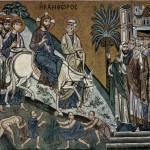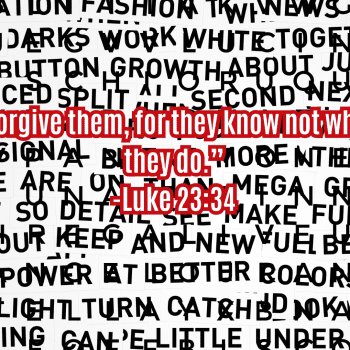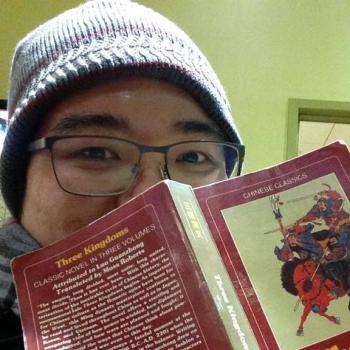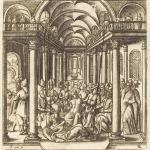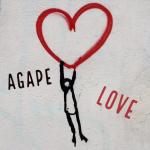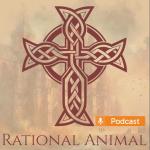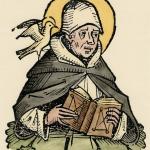![Under the Eastern Orthodox altar on Calvary (Golgotha) (now on the right after the main entrance in the Church of the Holy Sepulchre, Jerusalem) there is the place where it is believed Jesus died on the cross. - by adriatikus, 23 Jan. 2008 (5208-20080122-1255UTC--jerusalem-calvary.jpg) (CC BY-SA 3.0 [https://creativecommons.org/licenses/by-sa/3.0/deed.en]), via Wikimedia Commons](https://wp-media.patheos.com/blogs/sites/721/2017/04/5208-20080122-1255UTC-jerusalem-calvary-757x1024.jpg)
I discovered as I was entering the Kyivan Church that there were even more liturgical uses for the Gospel book than I had ever imagined since that first time that experience in the Latin Church struck me. The Gospel is brought out of the deacon door for the Little Entrance, and at my home temple, each of us line up during the Third Antiphon to kiss it before the priest (or bishop, more rarely) enters the holy doors with it with the words, Blessed be the entrance of your saints, both now and ever and for ages of ages, amen. During the Holy Mystery of Repentance, absolution is given as the penitent puts his or her head on the Gospel book and the spiritual father throws his epitrakhil (what Latins might call a stole) over the penitent’s head; the first time this happened to me was in public during my chrismation (I had confessed my sins the day before). The book of the Gospels is considered an icon of Christ; this is why we venerate it, put our heads against it, bring it out and in for the Little Entrance, and read it with such reverence at a central point in the Divine Liturgy before the Great Entrance. Christ is thus present in the book.
But as Great and Holy Week has opened, I feel that perhaps because of my new relationship to the Gospel book as an icon, I have been reading the Gospels for the first time as icons themselves. As I mentioned in my last post, I was reminded on Palm Sunday that the Byzantine tradition is to read the four holy Gospels during Great Week, and I have been trying to do that.
I don’t know if this tradition has anything to do with Bridegroom Matins – it probably doesn’t at an official level – but for me, it is merging at the level of pure experience, regardless of tradition. For Bridegroom Matins, we take our cue from the Lord’s parable of the ten virgins who were to meet the Bridegroom but only the prepared ones who had oil ready got to meet him when he came suddenly and in a rush. Meditating over the first three days of Great Week on the stories of Joseph the Patriarch in Genesis, the fig tree Jesus made to wither, and the contrast between Judas Iscariot and the woman who anointed Jesus’ feet, Bridegroom Matins has consistently shaken me out of my spiritual sloth this week, a week in which I feel like I am constantly juggling between the kairos time of Great Week and the heavy demands of my secular profession. It is no surprise that the tropar for Bridegroom Matins is:
Behold, the Bridegroom cometh at midnight,
and blessed is that servant whom He shall find watching;
but unworthy is he whom He shall find heedless.
Beware, therefore, O my soul,
lest thou be weighed down with sleep;
lest thou be given up to death, and be shut out from the kingdom.
But rouse thyself and cry:
Holy, Holy, Holy art Thou, O God,
through the Theotokos have mercy on us.
For some reason, it is singing Bridegroom Matins – and in my case, as a reader’s service at my icon corner because my secular academic job demands that I stay put instead of going the distance to a church to pray them as a community (which would have been much more ideal) – that has given me an appetite to open the Gospels and to read them, to seek – as Pope Emeritus Benedict XVI said it – the face of the Lord in the text of the Gospels.
Because of this, I’m discovering each of the Gospel accounts as showing different sides of the Lord’s face, as if they are four unique icons of Christ.
As I wrote yesterday, I saw the Lord work with the crowds in the account written by the Holy Evangelist Mark, slowly revealing himself and what his kingdom really entails through his actions with healing, exorcism, bread, the cup, and water. I beheld with fresh eyes how the kingdom is about is him giving himself to us as food, even as we drink from the same cup of martyrdom; in this is the cleansing of the sick and the possessed part of the greatest mighty deed of resurrection, the inauguration of the new creation.
The Holy Evangelist Matthew shows a different face, one of the Teacher with so much authority because he teaches with so much more primal truth than the Pharisees and the Herodians, uncovering in the same Torah tradition read by all the other teachers trying to compete with Jesus for spiritual wisdom that which was hidden from the foundation of the earth. What is this teaching? It is that to behold the face of G-d and not simply call him ‘Lord, Lord’ requires poverty and purity of heart at the primal depths of one’s being. It is that in this way, you can only have one Master: God or mammon. It is that only in one’s complete self-emptying and immersion into this new way of being is every jot and tittle of the Law and the Prophets fulfilled. No wonder when he dies, the earth splits open. No wonder when he rises, the only force that tries to put up a fight by spreading misinformation is Money. No wonder the Lord commands his disciples to go to the nations to baptize them into the life of the Triune G-d and thus into obedience to this teaching, the revelation of the primal things, that which had been hidden from the foundation of the earth but has been thrown open into plain view by the earthquakes of resurrection.
In the Gospel according to the Holy Evangelist Luke, I got a glimpse of what a prophet looks like: it is one whose body is filled with the Holy Spirit. Various persons are filled with the Spirit as the story opens – Mary Theotokos, Zechariah, Simeon, Anna, John the Baptist – and as they are filled, they burst with song and prophecy. Then, as Jesus is baptized, the Spirit moves the body of the Lord into the desert, and the Lord moves into ministry in the power of the Holy Spirit – a prophetic ministry, as both his admirers and his critics attest, because no one has ever seen anything quite like it with the healing and the teaching and the exorcising and the raising of the dead. The Lord is surrounded by those drawn to the Spirit, and the sense I get about who is in this crowd is that they are the poor – the tax collectors, the soldiers, the prostitutes, the disreputable, the outcasts; as the Lord says pointedly to those who doubt his ministry, ‘wisdom is vindicated by all her children’ (7.35), that is, this whole ragtag motley crew are those who turn out to be truly wise in the Spirit instead of the Pharisees and the lawyers. It is in the Spirit, then, that the prophetic ministry of the Lord crosses social boundaries, overturning norms where political loyalties and material wealth are supposed to be indicators of holiness because the Spirit cannot be bound by human conventions, divisions, and schisms; the Spirit challenges the existing political order through the prophetic body of Jesus. Because of this, the Lord wants us to know – at one point, he wants us to ‘let this sink into your ears’ – that prophets are not rich and powerful; prophets filled with the Holy Spirit get political, so they get killed. In the Spirit, the Lord goes to Jerusalem, the place where all the prophets go to die, the hill where the Lord’s final words are, ‘Father, into your hands I commend my spirit.’ And yet, as we learn when the Lord is risen and unfolds the Scriptures to the disciples on the road to Emmaus as well as in the upper room, all of this is but a fulfillment of the entire prophetic tradition from the Holy Prophet Moses onward, which will culminate in the same Spirit poured out onto Jesus’ followers themselves, making them also into prophets in this tradition.
And then there is Holy John the Theologian, the one who writes of the Logos in the beginning, the Logos who was before G-d, the Logos who is G-d himself. The Theologian writes of Theology – truly, ο λογος του θεου – who takes on flesh and comes into the world, not only showing himself to be the Light of Life shining in the darkness, but commanding that those in the world come out of the darkness into the light, come out of the world and be born from above. Jesus is Theology in the midst of the world, and the world attempts to grasp him, to seize him, to figure out why on earth one sent by G-d would work on the Sabbath, only to be confounded by the Theological statement that it is on the sabbath that the Father continues his work, the work of resurrection. Theology Incarnate offers everlasting life, then, a life of complete participation in this work of resurrection; there is no distance in relation to the one who is Theology, who only gives us his life if we eat his flesh and drink his blood. Those born from above are to love each other in the world, a cynical sphere of existence where the only honest man is Pilate who understands the logical implication of living for glory that can only come from others in the world and not from another plane – as he asks, What is truth? The Son of G-d, Word of the Father, sets us free from enslavement to the world by birthing us anew from on high; indeed, he is lifted up on the cross before the world – behold the man! – to draw the world to himself, out of its cynical darkness into the freedom of resurrection and the light of the life of love. This, Holy John the Theologian says, is Theology, the exegesis of the Father by the Son from his bosom, calling the world to participate through the Spirit in the renewal of its very existence, in the realization that it would not be able to contain all the books that could be written of all the works of Jesus.
With each angle, the face of our Lord, the icon of the Bridegroom, became clearer for me, though like Benedict, this is only a snapshot in what I have seen of the Lord up till now and no further. But why this merges with Bridegroom Matins for me is because all four of the Gospel accounts converge at the same place: the icon of the Bridegroom beaten, scourged, crowned with thorns, mocked as King of the Jews by the Roman occupiers, on his way to crucifixion. It is for this Bridegroom for which I am being told to stay awake and keep oil, because it is in the breaking of his body that he is given to me.
Perhaps some of my Protestant readers will be able to appreciate that I am still reading Scripture as an Eastern Catholic, and if that is so, I will be glad because I feel like this exercise during this Great and Holy Week is helping me break some of my old Protestant habits. I am hesitant to call my habits universally Protestant, but they were mine when I was a Protestant: trying to exegete the text of Scripture to get a formula for an almost legalistic application of the Word of God to my life, paying more attention to the structural form of the books than the substance of the stories and teachings themselves, trying to make everything fit through the lens of substitutionary atonement and a judicial understanding of salvation. As I am beginning to glimpse the Lord in the Gospel texts, I experience the text as an icon because as if for the first time, I feel the Lord’s gaze upon me as I read, stilling my heart and slowing me down so that I can contemplate the features illuminated by the intricate iconography.
I am reading the stories of Jesus, and Jesus is looking at me. I am tempted to read my own meaning into the text, but the gaze of the Lord makes me tremble in my bones. I want to get what I want from the Word, but the Lord gives me himself as the battered Bridegroom.
Lord, you have the words of everlasting life.

